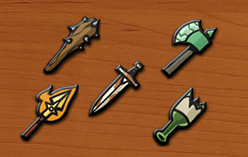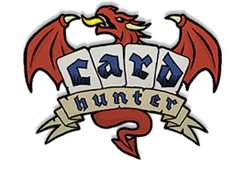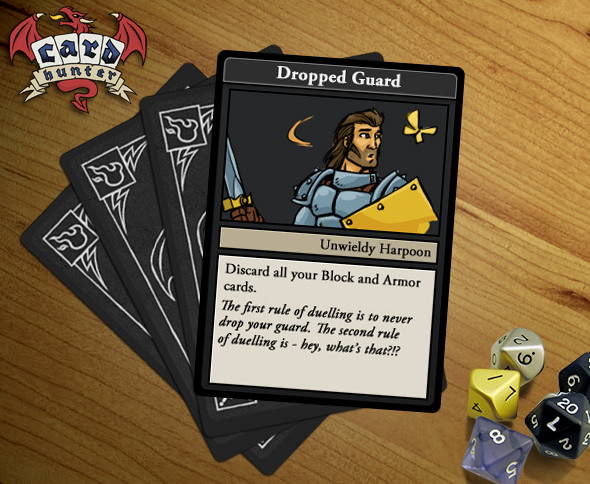Last week we introduced the basis of Card Hunter deck building – you make a deck by equipping items, each of which puts a suite of cards into your deck. I gave the example of the Puppeteer’s Headband which puts three cards into your deck – two copies of Teleport Other and another card called Maze of the Mind. Judging from the comments on the blog and in the forum, some of you thought this was pretty cool and some of you had some reservations about it. Will this system provide enough variety in deck building? Will it force you to equip lots of crappy cards that you don’t want? This week, I’ll try to address some of these questions and explain what I think is cool about this system.
Let’s start by talking about drawback cards, like this one:
When we previewed this card, you may have wondered why you would ever put it in your deck. After all, it’s clearly a pretty bad card that you don’t want to see in your hand. Now the reason why it is in your deck at all should be clear – you don’t want it to be there but it comes along with the other cards that you get when you equip a particular item, in this case the the Unwieldy Harpoon.
Let’s take a look at the full card suite for Unwieldy Harpoon:
You can see that it contains six cards:
- a Pinning Spear Toss
- three Predictable Stabs
- one Dropped Guard
- and one Fumble.
When you equip it, you get all of these cards. Of these, two are drawbacks! You can tell they are drawbacks by the black title bar. Similarly, you can tell that Predictable Stab is an average power card from its paper-like title and that Pinning Spear Toss is a very powerful card from its gold title bar. As an aside, it’s not the raw stats (5 damage and 5 range) that makes Spear Toss so great – it’s got some special text on it that makes it especially useful.
I wanted to reassure you about this week that the drawback cards aren’t going to be a huge part of the game – that you won’t end up with a hand full of them. Unwieldy Harpoon is a bad example for that argument! Fully one third of its cards are drawbacks. As you can imagine, Fumble ain’t a great card any more than Dropped Guard is. But the reality is that this is as bad as it gets. Unwieldy Harpoon is a pretty low level item and comes with one copy of a really powerful card – the Spear Toss – and so it also gets a couple of drawbacks to balance things out. Most weapons don’t have any drawbacks – or they just might have one. Two is unusual.
So why do we have these drawback cards at all? Three reasons, the first of which I’ve just mentioned: they’re a way of balancing out the items. We don’t have a mana system that makes powerful cards harder to cast and so we have to find another way of balancing things out so you don’t just end up with a hand full of the most powerful cards in the game.
Another reason is that they can actually be a skill-testing element when you are putting together your deck. Let’s consider Dropped Guard again, which says that you have to discard all your Block and Armor cards. That sounds bad – but what if you are building a very aggressive bezerker-themed deck that doesn’t have any Block or Armor cards? Hey, that card isn’t sounding quite so bad now. On the other hand, if you’re building a heavy duty tanking warrior who wants to stand on the front line blocking and soaking up damage, the Unwieldy Harpoon probably isn’t your best choice of weapons. Those are pretty simple examples, but finding ways of integrating these cards into your deck in the least painful way possible is going to be one of the things that distinguishes a good player from an average one.
And the last reason why these drawbacks can be fun is good old Schadenfreude – it’s fun when your opponent draws one. And, if you don’t take things too seriously, it can be fun when you draw one too – provided you can come back from your momentary lapse of fighting skill!
But equipment suites aren’t all about drawbacks. They also serve a number of other purposes in the game. One of the most important is that they throw a new deck building challenge at you. Not only do you now have to evaluate individual cards and how they will work together, but you have to figure out how suites of cards compare to each other. Is it worth taking that drawback card to get that really great card you have your eye on? What’s better – a bunch of average power cards or one really good one? And that’s before we throw in the next part of the system which is what kinds of slots you have to put these pieces of equipment in.

All of these weapons have their ups and downs. Well, broken bottles have more downs that ups, but you get the idea.
The point is that constraints often make games just as much as possibilities. In Magic, for example, the mana and colour systems are constraints. There would be more possible decks if you could just throw in whatever colour and mana cost cards you liked – but the game would be weaker because there would be less interesting decisions to make when building your deck. Equipment is a different kind of constraint, but hopefully one that is just as interesting and, importantly, one that challenges you to think about new kinds of problems.
Another thing we like about the equipment card suites is that they are flavourful. A flaming sword doesn’t just have to be a weapon which does normal damage plus fire damage, it’s a suite of Stab cards with a Fireball thrown in for good measure. And maybe a Parry to round things out. A more defensive weapon might have three Parries and a couple of Stabs. Cards maketh the weapon as well as the man.
And the final thing, which may not initially sound that exciting, but we think is actually pretty important, is that equipping items makes deck building a lot snappier than it might be. Don’t forget that in Card Hunter you have to build out three characters, each with their own deck. Putting individual cards for each character into those three decks might sound fun to the more hardcore, but it can get a bit tiresome. Equipping items that drop in suites of cards is a faster and easier to get your head around. Of course, tuning those choices to get them exactly right is still a big challenge for those that are looking for a real edge.
I hope that has gone some way towards explaining why we think this system is a good idea. There’s still a lot more to talk about including the slot system, how classes work and what role skills play in this whole deal. But we’ll save that for another time.





August 31st, 2011 at 12:24 pm
I love the idea!
Very excited about how you will solve this for the different types of armor.
August 31st, 2011 at 2:48 pm
I like this arrangement. I think it adds a great challenge that I haven’t seen before in card-based games. It’s kind of like if you take a MTG card and then split its constituent benefits/drawbacks into individual cards. You’re still playing the same card, but now you can potentially play it 3, 4, 5 or 6 different ways.
August 31st, 2011 at 3:15 pm
Ya, compared to last week this gets me all pumped up. Sounds like something we will just contemplate at first real quickly and throw something together at low levels but as we play, would become more challenging and take more time to consider which options are the best for our group of heroes. I’m eager to begin deck building right away!
August 31st, 2011 at 3:16 pm
OK! so it is like i thought last week… too bad, but only because i was expecting something different. if you advertise this project as online collectible card game, i immediatly think of exactly that. a collectible card game thats online!
but thats not the case here, because you cannot do the things you normally would in a collectible card game. swapping cards in and out to see if they fit your strategy, trading or selling unneeded cards, abusing powerful or weird cards. for me thats what ccgs are all about.
but looking at it from a different point of view, i think you are on your way to make a very good and interesting adventure tabletop game, like heroquest for example, but online. and i think it should be advertised as such! just to ensure nobody stupid, like myself, gets a wrong idea of this great project.
August 31st, 2011 at 4:51 pm
@Demonic Tutor: I think it’s still deckbuilding, it’s just deckbuilding that’s a bit different. Putting equipment in my deck just means putting a set of specific cards in my deck. The fact that they the designers then have more “knobs” to control in terms of creating weaknesses and downsides for powerful cards to keep things balanced… well that just seems like it will add more variety and interest to the game.
You have a point though that deck building, for me, is all about trying and discovering cool combinations – this system sounds like it creates combos FOR you to some extent. However I imagine there will still be a lot of space to discover – the example of building a Berserker deck to neutralize the Dropped Guard weakness was important, I think.
The limited slots are more concerning to me… it seems like that would introduce the most constraint and limitation in deckbuilding. I, too, play these games for the deckbuilding aspect… so I hope that none of this means that we won’t be free to be creative with trying combo decks, weird decks that abuse certain mechanics, etc. But I’m optimistic based on what they’ve shown so far.
August 31st, 2011 at 4:58 pm
Sorry to double-post, but I just thought of a question for the developers: these “downside cards” are confusing because we’ve heard nothing that indicates that they have to be PLAYED. Dev Diary #2 listed the round structure and there was nothing that said such cards needed to be played – so I would never actually play Drop Guard, i.e. I would never actually have to discard all my Block and Armor cards… right?
If that’s true, then this card is only “bad” in that it’s a dead card in your hand when you draw it – an opportunity cost.
But perhaps there’s a rule they haven’t stated – that you have to play these Downside cards whenever you draw them? That would make sense given the examples they’ve given.
August 31st, 2011 at 9:40 pm
@DemonicTutor: I hear your concern which I think is that our card suites are “building your deck for you” instead of allowing you to tweak your deck to your liking. Here’s one way of looking at though: you are building 3 characters with, let’s say, 12 slots each. That means you are making 36 choices of equipment items for your deck, which is as many choices as you are making when you are building a 36 card deck (slightly more than half the size of a Magic deck). Even though you can’t pick individual cards, there are still plenty of choices that you can make to maximise the synergy between your cards or to find and exploit combinations that other people haven’t thought of.
I’m sorry if you think we’re misrepresenting our game. We think of it as a CCG crossed with an RPG. It’s true that it’s not exactly one or the other. We hope it is still fun and interesting to play though.
August 31st, 2011 at 9:41 pm
@IQpierce: that’s a good question about the drawback cards. There is indeed a special rule that says that they must be played. There’s also at least one other special rule associated with those black cards that I will get to in a later diary.
August 31st, 2011 at 10:36 pm
@IQpierce @jon
please read my post again, it is not as pessimistic as you think!! its true that i posted a rather concerned comment last week. but again: only because i was expecting something different. you have to understand that when an old magic player reads ccg, deckbuilding and richard garfield on the same page, expectations go in a pretty clear direction.
im very interested in this game and will play it without hesitation. i think it will be a huge success and i hope you devs make good money from your hard work.
September 1st, 2011 at 7:03 am
much happier with the black cards and deck building ..having been slaughtered by mtg decks built by players with unlimited card resources it will be nice to know my deck oppptions even IF limited have beeen earnt as have my opponents
September 1st, 2011 at 8:33 am
@mordenkien – the drawbacks do not preclude people with more resources having better decks. While certain (maybe all?) weapons have drawbacks, it is still possible for a certain weapon to be plain better (have less drawbacks or a better +/- balance) than another. And if one can buy a lot of card packs…
September 1st, 2011 at 3:19 pm
I’m so pumped for this game. I’m keen to hear about what else, in addition to equipment, maketh the character/deck (if anything). Will there be character class suites? Race? Religion? Special quirks you can throw in at character creation time?
September 4th, 2011 at 5:16 pm
The thing that’s particularly interesting about this is that it leverages the strengths of the digital format. It’s a deckbuilding rule that you haven’t seen done before because you *couldn’t* do it in a paper game. Can you imagine trying to enforce it?
But in this case, the player couldn’t build a non-conforming deck if they tried.
September 4th, 2011 at 10:00 pm
Good point Tim. We prototyped the game using real cards and this part was a real pain to manage. On the computer though, it’s easy.
The computer’s access to hidden information is also critical to another part of the game that I’ll discuss soon.
September 4th, 2011 at 10:44 pm
Jon wrote: “There’s also at least one other special rule associated with those black cards that I will get to in a later diary.”
Now I have to try and guess what that special rule is!
Some possibilities:
1. Drawback cards ignore all other card text
In other words, they cannot be countered or mitigated directly. For example, if there was a card that read, “For each card you discard, perform X,” then that could potentially turn a Dropped Guard into a powerful card. While some of these interactions are interesting, in this type of game, there are too many possibilities of turning drawbacks into advantages, and if the design intent is for drawbacks to always be a negative or a restriction, then disallowing interactions with would ensure that intent is preserved. A player, of course, as mentioned, could still limit the liability such a card presents by clever deckbuilding.
2. If you draw multiple Drawbacks in the same action (draw phase or action), only one must be played. This prevents a case where a player is unlucky and draws too many drawbacks in a row.
3. If you draw multiple Drawbacks in the same action (draw phase or action), you choose the order in which they are played. Similar to #2, this simply gives the player a little more control over how things play out when they are hit that way.
4. If you draw a Drawback card as part of an action, the action resolves first. So for a card like Inspirational Thinking, you would have the opportunity to discard them. Another way of saying this would be that drawbacks put into your hand must be played immediately and in a case like Inspirational Thinking, they don’t go into the hand until the action is completed.
5. Whenever a Drawback card is played, you draw a card. Cards are valuable. More importantly, draws are valuable. Picking up a drawback card is a negative, obviously, but there’s a hidden negative here – you just lost a draw! This rule makes the drawback action itself the negative, without making it a double whammy on the player by taxing them a draw as well.
Ok, I will leave it at that for now. Very excited for this game!
September 5th, 2011 at 3:55 am
@Derek: lots of interesting ideas there. You didn’t quite hit what I was thinking of, though your guess #5 comes close. The thing is, when I said “black cards”, I wasn’t actually talking strictly about drawback cards. I realise that is also probably pretty opaque, but I will explain further soon.
Your point #3 is pretty a pretty accurate description of the sequence in which these kinds of cards must be played.
September 27th, 2011 at 5:47 pm
I realy love the ideas you guys have with the game system. Alot of cool stuff. I cant wait for it to come out.
So realese it soon guys *poke* *poke* on the devs.
Thumbs up for the game and good reading in the blog.